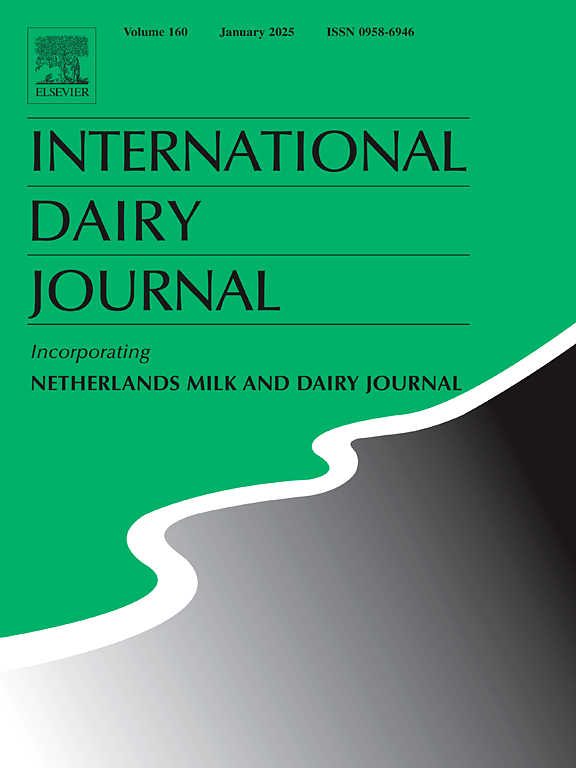Prevalence of potentially pathogenic and antimicrobial-resistant Escherichia coli in raw milk and dairy products in Egypt
IF 3.1
3区 农林科学
Q2 FOOD SCIENCE & TECHNOLOGY
引用次数: 0
Abstract
Milk and dairy products are popular in Egyptian diets, but their contamination with Escherichia coli, poses health risks. This study investigated the prevalence of potentially pathogenic and antimicrobial-resistant E. coli in raw milk and dairy products from Kafrelsheikh and Algarbia Governorates, Egypt. Two hundred ten samples including raw buffalo milk, goat milk, Domiati cheese, Domiati cheese with pepper, rayeb, and yogurt were analyzed. The prevalence of E. coli was 26.2%, with the highest occurrence in buffalo milk (68.0%) and the lowest in rayeb (7.5%). Based on ERIC-PCR, eighty-four non-clonal E. coli strains were selected and further characterized. Among tested virulence genes, adhesion genes such as lpfAO113 and ehaA, were the most prevalent. Toxin-encoding genes such as astA, cdt, cnf, and hlyA were also detected. The cytotoxic and hemolytic activity of cdt, cnf, and hylA carrying E. coli were confirmed on CHO cells and sheep blood agar, respectively. Twenty-three (27.4%) strains showed resistance to one or more antimicrobials, and 10 (11.9%) strains exhibited multidrug resistance (MDR). Among 12 antimicrobials tested resistance against ampicillin, streptomycin and tetracycline was the highest. Phylogenetic analysis and O-genotyping indicated clinically significant strains such as Og103, Og157 and OgGp9. Notably, two OgGp9 strains were OgGp9:Hg18 and phylogenetic group D, like those associated with a large diarrheal outbreak caused by milk consumption in Japan, in 2021. Interestingly, these two strains harbored a complete type 3 secretion system 2 locus (ETT2) and one of these strains was MDR. These findings indicate that these dairy products were contaminated with potentially pathogenic and multidrug-resistant E. coli. This is the first report to analyze E. coli contamination in Domiati cheese with pepper and detect OgGp9:Hg18 outbreak-associated strains with ETT2 and MDR in Egypt.
埃及原料奶和乳制品中潜在致病性和耐抗生素大肠杆菌的流行情况
牛奶和奶制品在埃及人的饮食中很受欢迎,但它们被大肠杆菌污染,对健康构成威胁。本研究调查了埃及Kafrelsheikh省和Algarbia省原料奶和乳制品中潜在致病性和抗微生物耐药性大肠杆菌的流行情况。对210份样品进行了分析,包括生水牛奶、羊奶、多米蒂奶酪、多米蒂奶酪加胡椒、酸奶。大肠杆菌感染率为26.2%,其中水牛奶的感染率最高(68.0%),羊奶的感染率最低(7.5%)。采用ERIC-PCR技术,筛选出84株非克隆型大肠杆菌,并对其进行进一步鉴定。在所检测的毒力基因中,粘附基因如lpfAO113和ehaA最为普遍。毒素编码基因如astA、cdt、cnf和hlyA也被检测到。分别在CHO细胞和羊血琼脂上证实了携带cdt、cnf和hylA的大肠杆菌的细胞毒和溶血活性。23株(27.4%)对一种或多种抗菌素耐药,10株(11.9%)耐多药。在所检测的12种抗菌素中,氨苄西林耐药率最高的是链霉素和四环素。系统发育分析和o基因分型显示Og103、Og157和OgGp9等具有临床意义的菌株。值得注意的是,两种OgGp9菌株是OgGp9:Hg18和系统发育组D,与2021年日本因牛奶消费引起的大规模腹泻疫情有关。有趣的是,这两株菌株都有一个完整的3型分泌系统2位点(ETT2),其中一株是耐多药。这些发现表明,这些乳制品被潜在致病性和耐多药大肠杆菌污染。这是在埃及首次分析加胡椒的Domiati奶酪中大肠杆菌污染并检测与ETT2和耐多药相关的OgGp9:Hg18菌株的报告。
本文章由计算机程序翻译,如有差异,请以英文原文为准。
求助全文
约1分钟内获得全文
求助全文
来源期刊

International Dairy Journal
工程技术-食品科技
CiteScore
6.50
自引率
9.70%
发文量
200
审稿时长
49 days
期刊介绍:
The International Dairy Journal publishes significant advancements in dairy science and technology in the form of research articles and critical reviews that are of relevance to the broader international dairy community. Within this scope, research on the science and technology of milk and dairy products and the nutritional and health aspects of dairy foods are included; the journal pays particular attention to applied research and its interface with the dairy industry.
The journal''s coverage includes the following, where directly applicable to dairy science and technology:
• Chemistry and physico-chemical properties of milk constituents
• Microbiology, food safety, enzymology, biotechnology
• Processing and engineering
• Emulsion science, food structure, and texture
• Raw material quality and effect on relevant products
• Flavour and off-flavour development
• Technological functionality and applications of dairy ingredients
• Sensory and consumer sciences
• Nutrition and substantiation of human health implications of milk components or dairy products
International Dairy Journal does not publish papers related to milk production, animal health and other aspects of on-farm milk production unless there is a clear relationship to dairy technology, human health or final product quality.
 求助内容:
求助内容: 应助结果提醒方式:
应助结果提醒方式:


